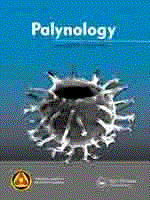This is the first detailed stratigraphic correlation of Lower and Middle Miocene deposits in the Gulf of Suez, Egypt using dinoflagellate cysts. The correlation is based on 273 ditch-cutting samples from five onshore boreholes located along the southwestern margin of the Gulf of Suez. The interval studied is represented by the Nukhul, Rudeis and Kareem formations of the Gharandal Group, and the lower part of the Belayim Formation of the Ras Malaab Group. These Miocene deposits unconformably overlie the Lower or lower Middle Eocene. The dinoflagellate cyst record is more diverse than previously reported and many taxa are documented for the first time in Egypt. Five biozones are established and tied to a chronostratigraphic framework by calibration to calcareous nannofossils (NN biozones) obtained from the same set of samples: (1) Lingulodinium machaerophorum Assemblage Biozone (GOSl), Aquitanian through mid-Burdigalian; (2) Exochosphaeridium insigne Taxon-range Biozone (GOS2), lower through mid-Burdigalian; (3) Apteodinium spiridoides Interval Biozone (GOS3), mid-Burdigalian through lower Langhian; (4) Cleistosphaeridium placacanthum Interval Biozone (GOS4), upper Burdigalian, Langhian, and lower Serravallian?); and (5) Polysphaeridium zoharyi Assemblage Biozone (GOS5), upper Langhian and Serravallian?Comparison with other Miocene biozonations from the Mediterranean, Central Paratethys, North Atlantic region, and eastern USA indicate that the highest occurrences of Apteodinium spiridoides, Cordosphaeridium cantharellus, Distatodinium paradoxum, Exochosphaeridium insigne and Cleistosphaeridium placacanthum, and the lowest occurrences of Exochosphaeridium insigne and Sumatradinium soucouyantiae are important datums, whereas the lowest occurrences of Hystrichosphaeropsis obscura, Labyrinthodinium truncatum, and Operculodinium? borgerholtense provide useful supporting age control.
How to translate text using browser tools
1 June 2012
Lower and Middle Miocene biostratigraphy, Gulf of Suez, Egypt Based on Dinoflagellate Cysts and Calcareous Nannofossils
Ali Soliman,
Stjepan Ćorić,
Martin J. Head,
Werner E. Piller,
Salah Y. El Beialy
ACCESS THE FULL ARTICLE
It is not available for individual sale.
This article is only available to subscribers.
It is not available for individual sale.
It is not available for individual sale.

Palynology
Vol. 36 • No. 1
June 2012
Vol. 36 • No. 1
June 2012
calcareous nannofossils
Dinoflagellate cysts
Egypt
Gulf of Suez
Miocene




